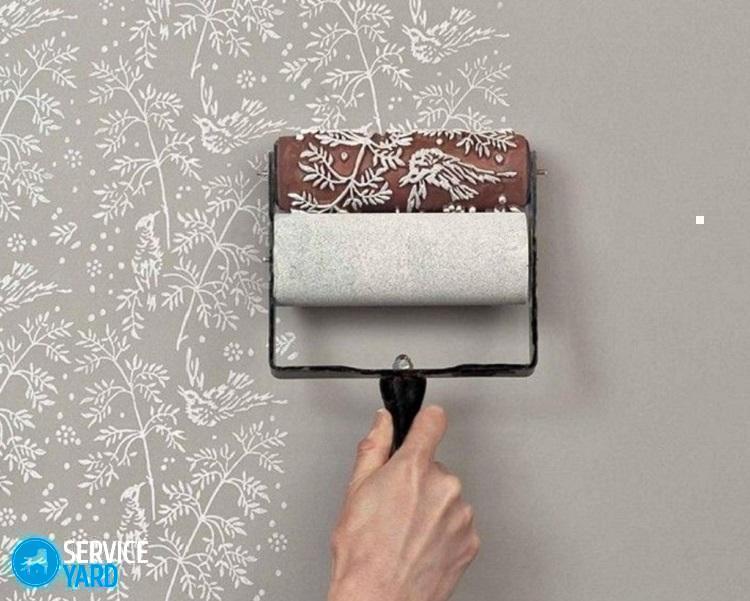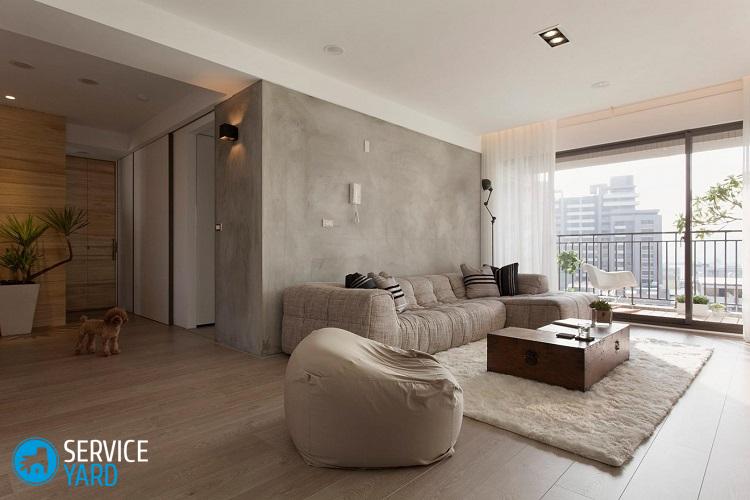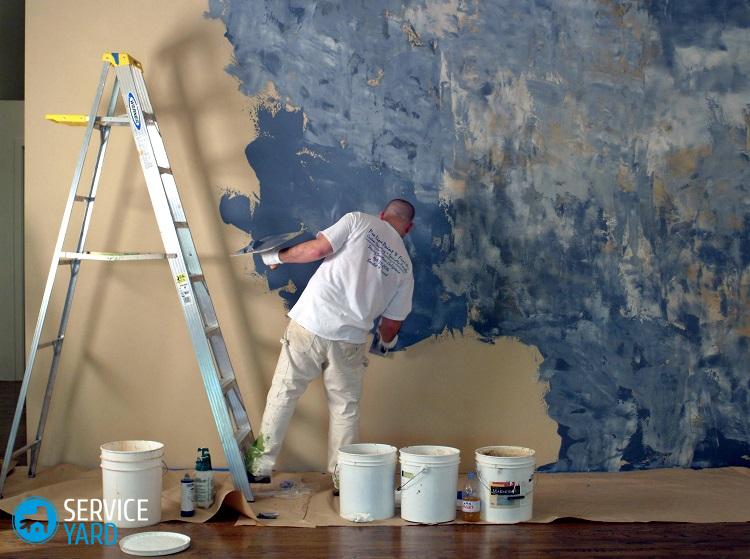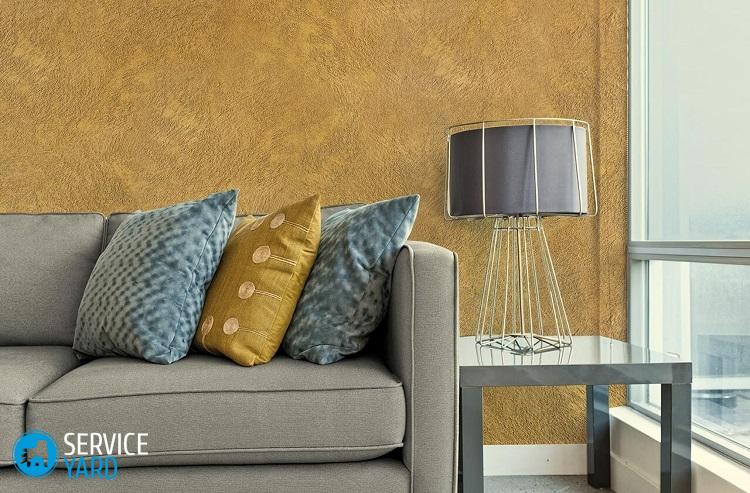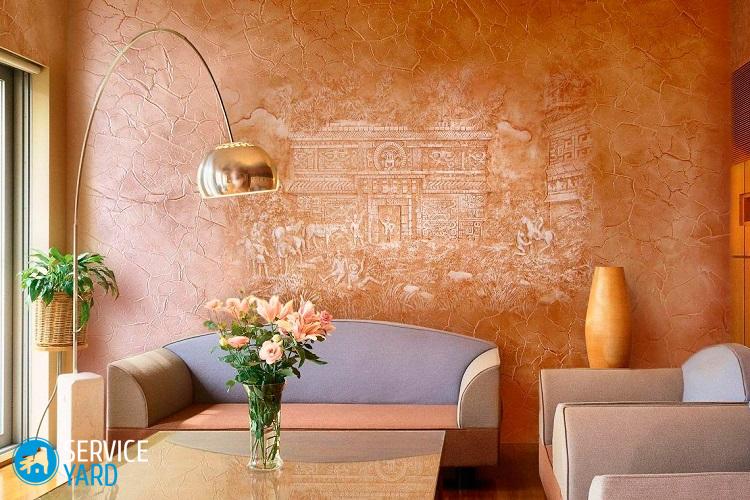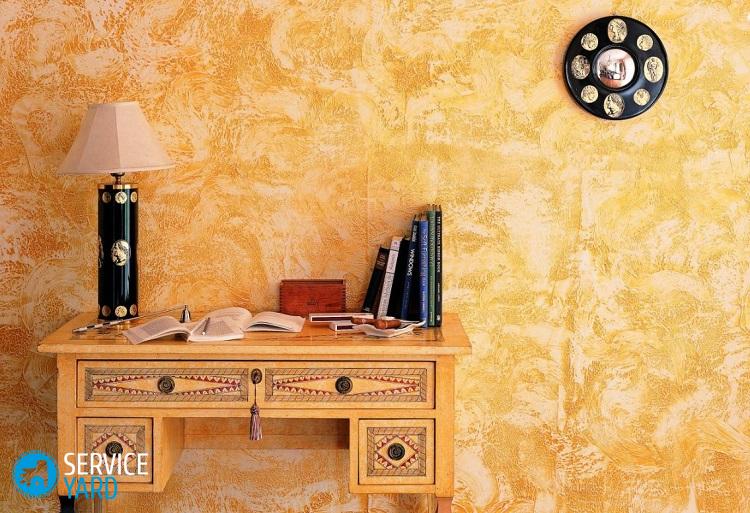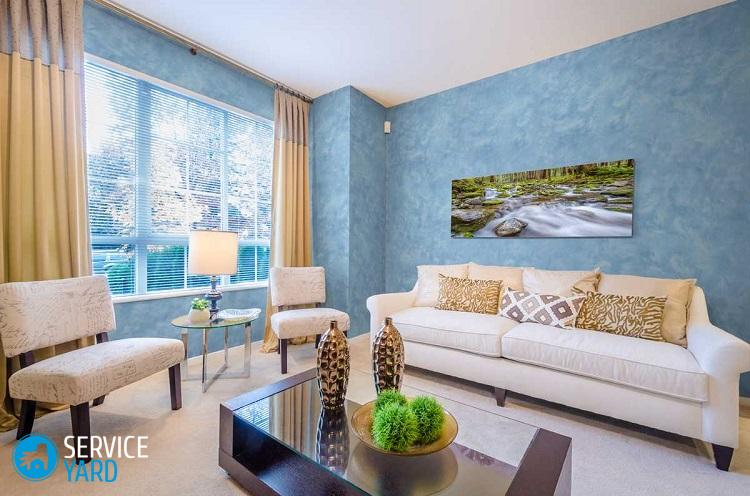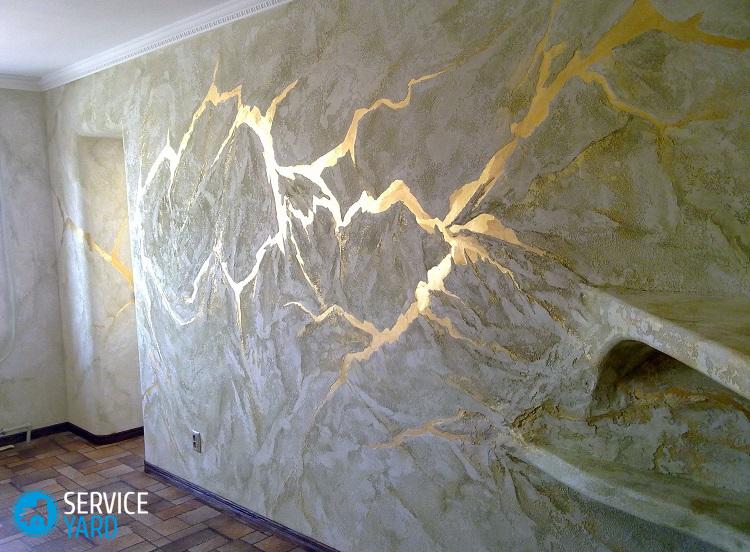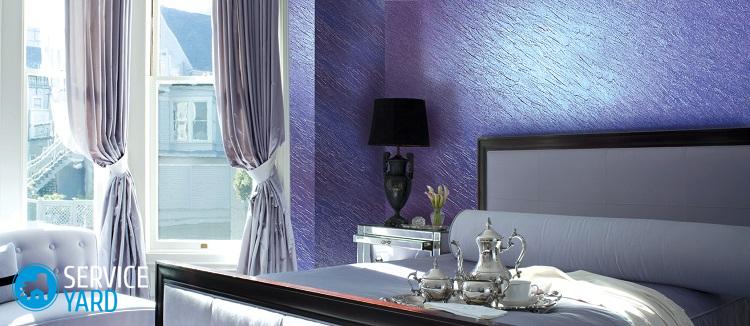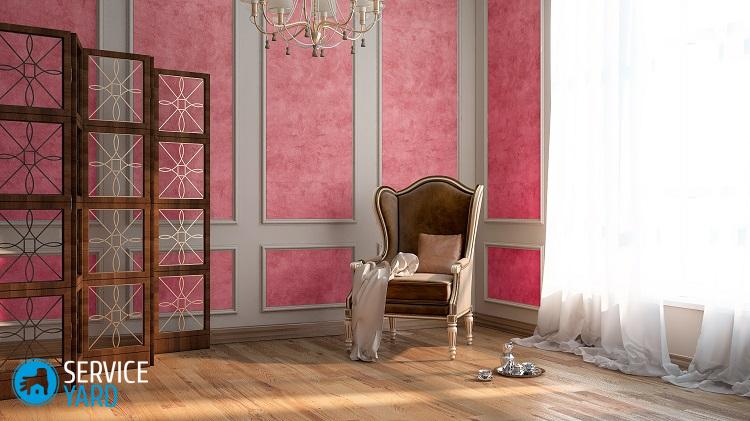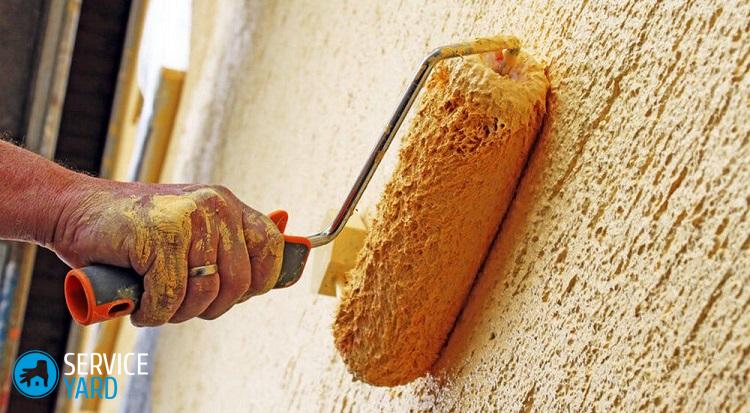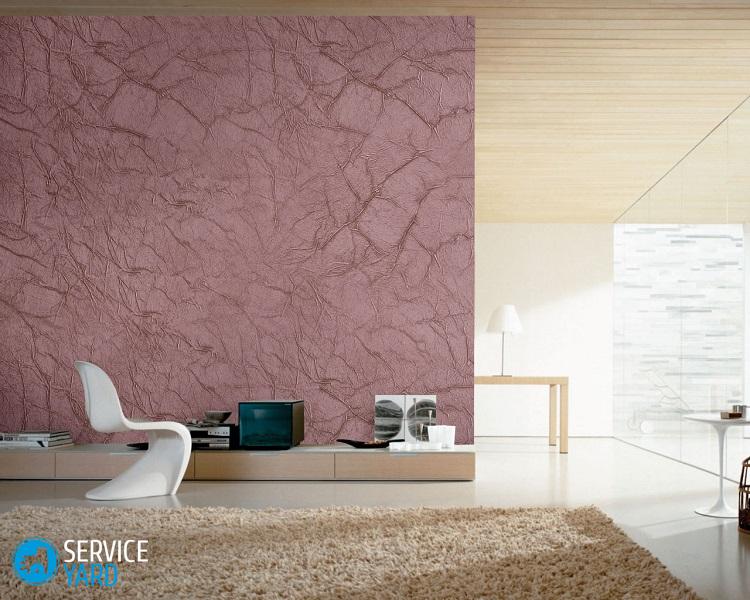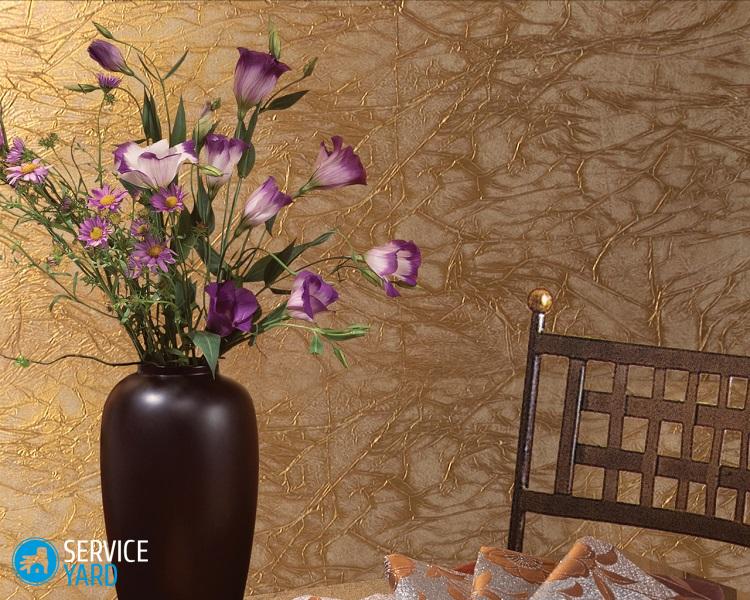Textured wall paint
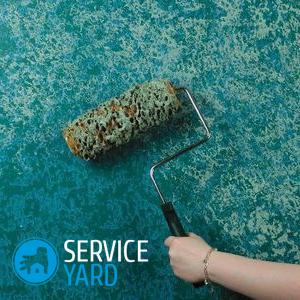
- Varieties of decorative paints
- Composition and properties
- Types of fillers in structural paints
- Advantages and disadvantages of textured paints
- Optimum Dye Selection
- Standard textures for walls
- What is needed for applying textured paint?
- Creating a decorative finish with spatulas, brushes and rollers
- Preliminary preparation of walls for painting
- Features of applying liquid textured paint
- Dry paint technology
- Methods for decorating paint
- Stock footage
Textured wall paint in a modern interior design is a popular finish. Unusual patterns and unique paint distribution on the walls make the work unique. Due to the relief and volume of the patterns, real compositions are created that combine the skills and imagination of the mater. Let's find out what these paints are, their advantages and disadvantages, as well as the technology of working with them.
to contents ↑Varieties of decorative paints
Structural dyes are presented on store shelves in two versions:
- Liquid - these formulations are completely ready for use. They already have the right shade, so there is no need to use a color scheme.
- Dry - the second name of such compounds is “decorative plaster”. This type of dye is diluted with water, where dye is added to give the desired color.
Composition and properties
Acrylic latex used in the manufacturing process of textured paints undergoes polymerization in the process of evaporation and absorption of moisture. Due to this, the drying time of the paint is only a couple of hours.
to contents ↑Important! As a result of the use of the material in its pure form, a finishing layer with a thickness of about 0.2-2 mm is formed on the surface. If you add some additional components to the dye, for example, sand, sawdust and other materials, you can increase the layer thickness to 1 cm.
Types of fillers in structural paints
The relief and density of the textured paint is ensured by the particles that are included in its composition. Varieties of such finishing materials are also classified by type of fillers, which may include the following:
- Granite or marble chips.
- Gas silicate in crushed form.
- Quartz sand.
- Metal particles that have a reflective surface.
- Sawdust.
- Synthetic or natural fibers
Important! In addition, the composition may contain modified starch as a thickener, as well as special pigments, due to which it is possible to obtain a dye for walls with the effect of a pearlescent coating or silk. Typically, such particles are in the form of flakes or drops.
The depth of the structure of the dye and its relief depends on the particle size of the filler:
- Coarse-grained - the composition contains fractions with a diameter of 1-2 mm.
- Medium-grained - include particles with a size of 0.5-1 mm.
- Fine-grained - are made on the basis of filler particles with a diameter of not more than 0.5 mm.
to contents ↑Important! Before you purchase graphite wall paint or another type of dye, you should familiarize yourself with the manufacturer's advice on how to use it. The basis for applying the material may be wood, plaster, masonry made of stone or brick, concrete surface.
Advantages and disadvantages of textured paints
The advantages of textured paints include the following:
- Long service life - the average is 10 years.
- The ability to update the coating by applying a new layer of dye without the need for prior removal.
- Safety and environmental friendliness.
- Resistant to sunlight and mechanical stress. In addition, the surface does not provoke the development of fungus and mold.
- The ability to create a monolithic coating.
- The choice of design solutions, textures and shades will not make the user think about how to get an unusual result.
- The universality of the paint makes it possible to use it for decorating the walls of bathrooms, nurseries, kitchens, living rooms.
- Unique textured pattern.
- Rich appearance.
- The decorative coating has antistatic properties, due to which dust repels from the surface.
- The excellent vapor permeability of the coating does not create obstacles to the movement of air masses in the room.
- Easy to clean due to washable surface. In addition, this paint repels dirt well.
Important! This is especially true for switch zones and corners.
However, in addition to all the advantages of textured paints for walls, there are also disadvantages:
- The need for preliminary preparation of the foundation. Although this coating is well applied to the finishing putty, wood panels, chipboard, gypsum board, plywood, glass and metal, still the surface of the walls must be flat before painting. However, small cracks in it paint can fill itself.
- Increased material consumption, which is approximately 1 kg / m2 of walls. This fact significantly affects the total cost of coverage, increasing it.
to contents ↑Important! Decorative textured paint for interior decoration can be safely used to decorate a kitchen or bathroom, where there is an increased level of humidity. After the composition has dried, the surface of the walls will be reliably protected from moisture and mold.
Optimum Dye Selection
The most important criterion for choosing textured paint is the basis of the dye. Given this parameter, several types of materials for creating textures are distinguished:
- Silicone paint is the most common type of dye, which is designed for indoor and outdoor use. The material makes it possible to create a vapor-permeable coating resistant to the effects of negative environmental factors (temperature changes, moisture).
- The mineral composition is the cheapest powder finish. As a rule, dye is used to decorate the exterior walls of buildings.
- Silicate dye - is considered the most expensive option, but at the same time it is practical in use. The coating is not afraid of external influences, and it is also easy to care for and remarkably repels dirt and dust particles.
Important! The material must be used with a primer that has a similar base.
- Acrylic paint - it appears in a ready-made form, so it is very convenient to use it. It is allowed to add fillers and tints necessary to create a certain effect for color adjustment.
Standard textures for walls
There are several basic textures that can be obtained using textured wall paint:
- Embossed - the formation of such a coating is done using special fillers in the paint. The application technology is quite simple, so even a person who does not have experience can cope with the work.
- Mizuri - to implement this kind of coating will have to spend a lot of effort. For this we need a textured paint, which is made on an acrylic basis with the addition of modified starch. With the help of this composition, you can create both a texture and a flat surface.
- Marseille wax - in this case, the finish is stylish and refined, however, to create it, you will need professional skills and knowledge. Using the material, you can make a realistic imitation of wood bark, cork or aged stone. To get a deep saturated color, the finish is covered with a special decorative wax. The material is appropriate for both the internal and external surfaces of the walls. It can be used in living rooms and office premises, swimming pools, restaurants.
- Atacama is a special application of paint, in which the surface acquires a very beautiful reflective effect, if metal pigments or quartz sand of the required fraction is added to the base. In fact, it turns out something like a wall paint with a velvet effect, which has a soft and shimmering surface.
to contents ↑Important! The best result of applying textured paint is obtained when both the base and the paint composition itself have room temperature.
What is needed for applying textured paint?
To work with textured paint you need a certain set of tools, so before you begin the steps, you should take care of the following:
- Capacities of the appropriate size (buckets or basins).
- Construction mixer (drill with a special nozzle).
- A set of paint brushes of different sizes, as well as with different stiffness of the pile.
- Natural or foam sponge.
- Spray gun.
- Paint rollers.
- Set of spatulas.
- Rule (length 2-3 m).
- Master OK.
- Grater.
- Cellophane film and protective equipment (gloves, glasses, long-sleeved clothing, cap or bandana).
to contents ↑Important! In order to get the original painting of the walls, you can use a pneumatic sprayer. Filling it with the paint of the desired color, set the pressure at around 5 atmospheres and install a nozzle with a diameter of 0.3-0.5 cm into the device.
Creating a decorative finish with spatulas, brushes and rollers
The resulting texture depends not only on the coloring composition itself, but also on the tool that is selected for its application. For these purposes, you can use spatulas, rollers, combs, brushes and even improvised means:
- Wide stiff brush - the material can be applied to the wall using vertical, horizontal, cross, wavy and other movements.
- Comb - used for a more pronounced relief with rare patterns. It is applied in the same way as a brush.
- Spatula - dye is applied to the surface with a thin layer, with sharp rough movements. As a result, an imitation of stone is obtained. This method is difficult to master immediately without the presence of certain skills.
- Roller with fur and foam sponge - used to obtain a rough uniform surface by rolling up and down the wall. The texture will depend on the type of sponge and the structure of its coat.
- Figured roller - the tool has a relief surface with a protruding outward pattern imprinted on fresh paint. So that the texture does not interrupt during application, it is advisable to process the wall section to the entire height (from the ceiling to the floor).
- Soft paper, textiles or natural sponge - to work with these items you need to use the technique of “trimming”. In other words, with the help of the material, the freshly painted surface is simply stamped.
- Trowel - staining is obtained by applying paint in two layers. To work with the first layer, you must use a spatula, and with the second - a trowel. A day after the finish is completely dry, the surface is covered with dull white enamel with a fur roller.
to contents ↑Important! There are alternative ways of applying the texture: wrapping the roller with a rope or rags (the effect of bamboo stems), fingers (in rubber gloves), blows of a wet rag.
Preliminary preparation of walls for painting
Preliminary preparation of the wall surface for applying textured paint is as follows:
- Cover the floor and ceiling with foil to prevent dirt and splashes. Use adhesive tape to fix the material.
- Check the wall for vibration resistance, as this may cause paint to crumble in the future.
- Remove the old coating from the wall, clean its surface.
- Apply a layer of plaster in order to eliminate cracks and potholes.
- To improve the adhesive characteristics of the dye, coat the wall with an acrylic primer. Use a paint roller during operation.
Important! The color of the primer should match the color of the dye. In the process, work must be carefully monitored so that the material is distributed evenly.
After applying the primer mixture to the wall, allow time to dry. This will take at least 5 hours. The drying time depends on the air temperature and the humidity level in the room.
to contents ↑Features of applying liquid textured paint
Often, when working with liquid textured paints, a roller or a paint brush, a foam sponge are used, less often a spray gun. You can also wrap a rag over the roller. When performing staining, you should adhere to the following:
- First, mix the material in the container and dip the tool selected for work there.
- In the process, it is imperative to adhere to one technique so that the pattern is the same and uniform throughout the room, otherwise the result will be ugly.
- The paint is applied from top to bottom, so you can avoid ugly drips.
- For drawing the first layer, as a rule, a brush or roller is used. After it is completely dry, you can use a regular or figured roller to paint the wall and a dye of a different color.
- Start work is from those areas where the room is poorly lit, carpets or furniture will hang. If the hand is still a little full, then in these areas possible defects will be less visible.
- The last coat of paint is recommended to be applied in the direction of sunlight.
Dry paint technology
To work with dry textured wall paint, you must adhere to the following recommendations:
- You should take a container for dilution and mixing of the composition. The most optimal option would be a 10-15 liter bucket.
- Next, you need to open the bag with the dye and fill it with half capacity. If the idea is to introduce some fillers into the composition, then a quarter of its volume is poured into the container. After this, the dye must be diluted with water in the ratio indicated by the manufacturer on the package.
- Mix the composition thoroughly. For these purposes, it is better to use a construction mixer. Mixing of the material is carried out for 5-10 minutes. In order not to carry a heavy bucket throughout the room, you can shift part of the finished mixture with some other capacity - its width should be greater than the width of the spatula.
- If a filler with particles larger than 2 mm was added to the composition, the dye should be applied with a smooth spatula. To work with the mass, which is composed of regular or quartz sand as a filler, it is better to use a toothed or flat spatula. Recommended clove width is approximately 1-2 mm. If you use a tool with wider teeth, the pattern may be too rough.
Important! Recommended coverage area in one run is approximately 1-2 m2. The initial hardening of the composition occurs within 15 minutes, after which it will be impossible to accurately correct the pattern.
The application technique is as follows:
- Pick up a small amount of dye with the tool.
- Using a smooth trowel, apply the composition to a wall of 1 m2 with up and down movements.
- Align the dye with a wide spatula in horizontal movements.
- Apply the pattern with a fine-trowel or other tool.
Methods for decorating paint
For decorating walls that are painted with textured paint, you can use different techniques:
- A stencil - patterns for work can be bought in a specialized store or made independently. To do this, linoleum, sheet plastic or a thick film is suitable.
- Star dust - in this case, contrasting specks are applied in a different color to the surface of the painted wall using a brush with hard bristles. To do this, squeeze out excess paint, bend the pile in the direction from the wall and just let it go.
- Contrast - a combination of contrasting shades looks very attractive. Variation of shades can be on the same wall, or on different ones (in the form of contrasting geometric shapes, for example, squares, rhombs).
- Aged surface - a dye of a contrasting color must be applied to the painted surface and worked through with repeated touches of a sponge or brush before the composition begins to dry.
Stock footage
At the last stage, the surface painted with textured paintIt is covered with interior varnish, which will make the pattern more expressive. However, the paint application options do not end there - it all depends on your imagination and the availability of improvised tools. The main thing is to observe safety precautions during work: wear glasses and a hat, use gloves and work clothes.
- How to choose a vacuum cleaner taking into account the characteristics of the house and coatings?
- What to look for when choosing a water delivery
- How to quickly create comfort at home - tips for housewives
- How to choose the perfect TV - useful tips
- What to look for when choosing blinds
- What should be running shoes?
- What useful things can you buy in a hardware store
- Iphone 11 pro max review
- Than iPhone is better than Android smartphones



